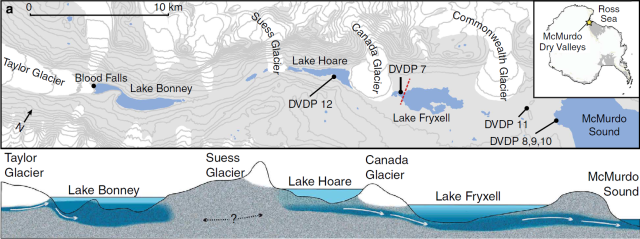
It’s easy to forget that Antarctica is a desert, given that very nearly the entire continent is covered by a thick sheet of ice. But snowfall is very slow to add to that white mantle, as the cold air and ocean around Antarctica aren't exactly going to provide prodigious production of atmospheric moisture.
As its name implies, one of the driest and weirdest locales in a very weird continent is the McMurdo Dry Valleys. This area near the coast is the biggest chunk of Antarctica not covered by ice. Bare rock is found there, and not a whole lot else.
There is, however, an unusual feature known as Blood Falls. At the end of Taylor Glacier, which spills into one of the Dry Valleys (Taylor Valley, actually), a mysterious red trickle of salty, iron-rich water periodically stains the ice as it spills out like blood from a wound. It’s a good thing that it isn’t a paranormal message from ghosts warning researchers to leave the valley, because it has had the opposite effect—it draws them in. In 2012, for example, biologists looking for signs of life eking out an existence in the Dry Valleys discovered that Blood Falls contained an impressive community of microbial life.
It is thought that the weight of the glacial ice is squeezing these periodic flows out of the sediment beneath, but the bigger question is what that water is doing there in the first place. It’s cold enough in this area that Taylor Glacier should be frozen to its bed—which ought to be made of frozen sediment. But that assumes fresh water. The Blood Falls water is salty enough to stay liquid down to -6 degrees Celsius at surface pressure (and could go lower at higher pressure). So where is this briny water coming from?
To learn more, a group led by University of Tennessee, Knoxville microbiologist Jill Mikucki flew a giant electromagnetic transmitter up Taylor Valley. The huge loop induces an eddy current that penetrates below ground, and a smaller pick-up coil measures the decay of the resultant magnetic field. That produces measurements of electrical resistivity, which differs between ice, freshwater, and salty water.
Two huge, low-resistivity zones consistent with brine-soaked sediment made a surprise appearance amidst the permafrost. There are three salty, ice-covered lakes in the valley fed by the small amount of meltwater that forms atop the glaciers—one lake at the snout of Taylor Glacier and two lakes astride Canada Glacier, which dumps into the valley halfway between Taylor and the sea. There's also briny groundwater that is at least as salty as those lakes and seems to connect to them.
One zone of groundwater extends from beneath Taylor Glacier—where Blood Falls is—to underlie the lake there. The other groundwater zone appears to join the two lakes separated by Canada Glacier and then reaches all the way to the sea, oozing below a thick surface layer of permafrost.

There were actually a few boreholes drilled in the area in the 1970s, a couple of which either produced some brine or hinted at the possibility of water, but it was pretty unclear whether this was something quirky and local or an indication of a larger sub-zero groundwater system.
As for the source of this super-salty groundwater, thinking about Taylor Valley as it is today won’t give you an answer. You have to go way back—like more than 10 million years back. During that warmer period, sea level was higher, and Taylor Valley was a seawater-filled fjord. As the climate cooled, the freezing of that seawater could have increased the saltiness of any remaining water, since crystallizing ice rejects salt. The chemistry of the water at Blood Falls, for example, matches concentrated seawater. That saltier seawater could have soaked into the valley floor, remaining to the present day.
So it seems likely that Blood Falls’ source is this briny groundwater. And if there are bacteria living in the water of Blood Falls, it stands to reason those bacteria live in the groundwater, as well—an unexpected ecosystem in a terribly inhospitable environment surviving because the water is too salty to yield to the frigid temperatures. Those bacteria are probably getting their energy from breaking down minerals in the sediment.
All this is interesting for understanding the McMurdo Dry Valleys, but researchers also study this area as a possible analog for Mars. Perhaps salty groundwater once provided an unlikely bastion for life in the harsh environment of the Red Planet, too.
Open Access at Nature Communications, 2015. DOI: 10.1038/ncomms7831 (About DOIs).
reader comments
13